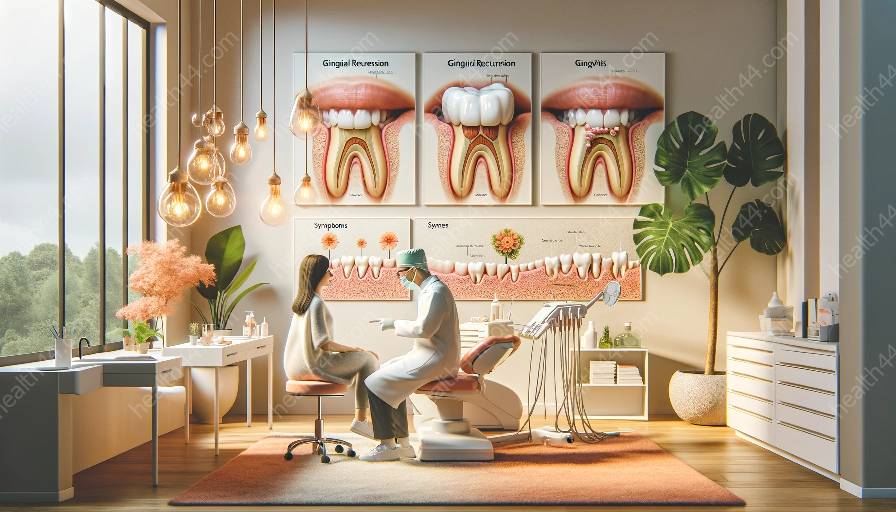The gingiva, commonly known as the gums, is a crucial component of the oral cavity, playing a pivotal role in supporting dental health. Understanding the anatomy and physiology of the gingiva is essential for comprehending conditions such as gingival recession and gingivitis.
Anatomy of the Gingiva
The gingiva consists of the soft tissues that surround the teeth and cover the underlying alveolar bone. It is a composite of two major parts: the free (marginal) gingiva and the attached gingiva.
- Free (Marginal) Gingiva: This portion of the gingiva extends from the gingival margin to the base of the gingival sulcus. It forms a collar-like band around the teeth and is readily movable.
- Attached Gingiva: Located between the free gingiva and the mucogingival junction, the attached gingiva is firmly bound to the underlying periosteum. It provides stability and resilience to the gingiva and aids in withstanding the forces endured during mastication and other oral functions.
Structure of the Gingiva
The gingiva is composed of various layers that collectively contribute to its structural integrity and function.
- Epithelium: The gingival epithelium comprises stratified squamous epithelium that forms a protective barrier against external irritants and bacteria. It also contributes to the seal between the tooth and the surrounding tissues.
- Connective Tissue: The connective tissue of the gingiva includes the gingival fibers, which provide support and help maintain the position of the gingiva. These fibers are crucial for the attachment of the gingiva to the tooth and the alveolar bone.
Physiology of the Gingiva
Healthy gingiva is essential for providing support and protection to the teeth, maintaining oral health, and ensuring proper functioning of the oral cavity. The gingiva plays a pivotal role in preventing the penetration of harmful bacteria into the underlying tissues and bone, thus safeguarding against periodontal diseases such as gingivitis and periodontitis.
An adequate blood supply and lymphatic drainage are crucial for the maintenance of healthy gingival tissue. The gingiva receives its blood supply from numerous branches of the superior and inferior alveolar arteries. Proper lymphatic drainage is essential for the removal of waste products and cellular debris from the gingival tissues.
Gingival Recession
Gingival recession, also known as receding gums, occurs when the margin of the gingiva pulls back, leading to exposure of the tooth root. This condition can result in tooth sensitivity, esthetic concerns, and increased vulnerability to dental caries.
Several factors contribute to gingival recession, including:
- Poor Oral Hygiene: Inadequate or aggressive brushing, and flossing practices can contribute to gingival recession by causing mechanical trauma to the gingiva.
- Genetic Predisposition: Genetic factors can influence the thickness and resilience of the gingival tissues, making some individuals more susceptible to gingival recession.
- Periodontal Disease: Advanced periodontal disease can lead to the destruction of the supporting tissues surrounding the teeth, causing the gingiva to recede.
Proper oral hygiene practices, regular dental visits, and timely treatment of periodontal disease are essential for preventing and managing gingival recession. In severe cases, surgical procedures such as gingival grafting may be necessary to restore the lost tissue and cover the exposed root surface.
Gingivitis
Gingivitis is a common and reversible form of periodontal disease characterized by inflammation and bleeding of the gingiva. It is primarily caused by the accumulation of plaque, a sticky film of bacteria and food debris that forms on the teeth.
When plaque is not regularly removed through proper oral hygiene practices, it can irritate the gingival tissues, leading to inflammation. If left untreated, gingivitis can progress to more severe forms of periodontal disease, ultimately resulting in irreversible damage to the supporting structures of the teeth.
Symptoms of gingivitis include red, swollen, and tender gums, as well as bleeding during brushing or flossing. Proper oral hygiene, including regular brushing, flossing, and professional dental cleanings, is crucial for preventing and treating gingivitis.
Understanding the anatomy and physiology of the gingiva is instrumental in comprehending the impact of conditions such as gingival recession and gingivitis on oral health. By prioritizing proper oral hygiene and seeking timely dental care, individuals can maintain healthy gums and mitigate the risk of gingival complications.













